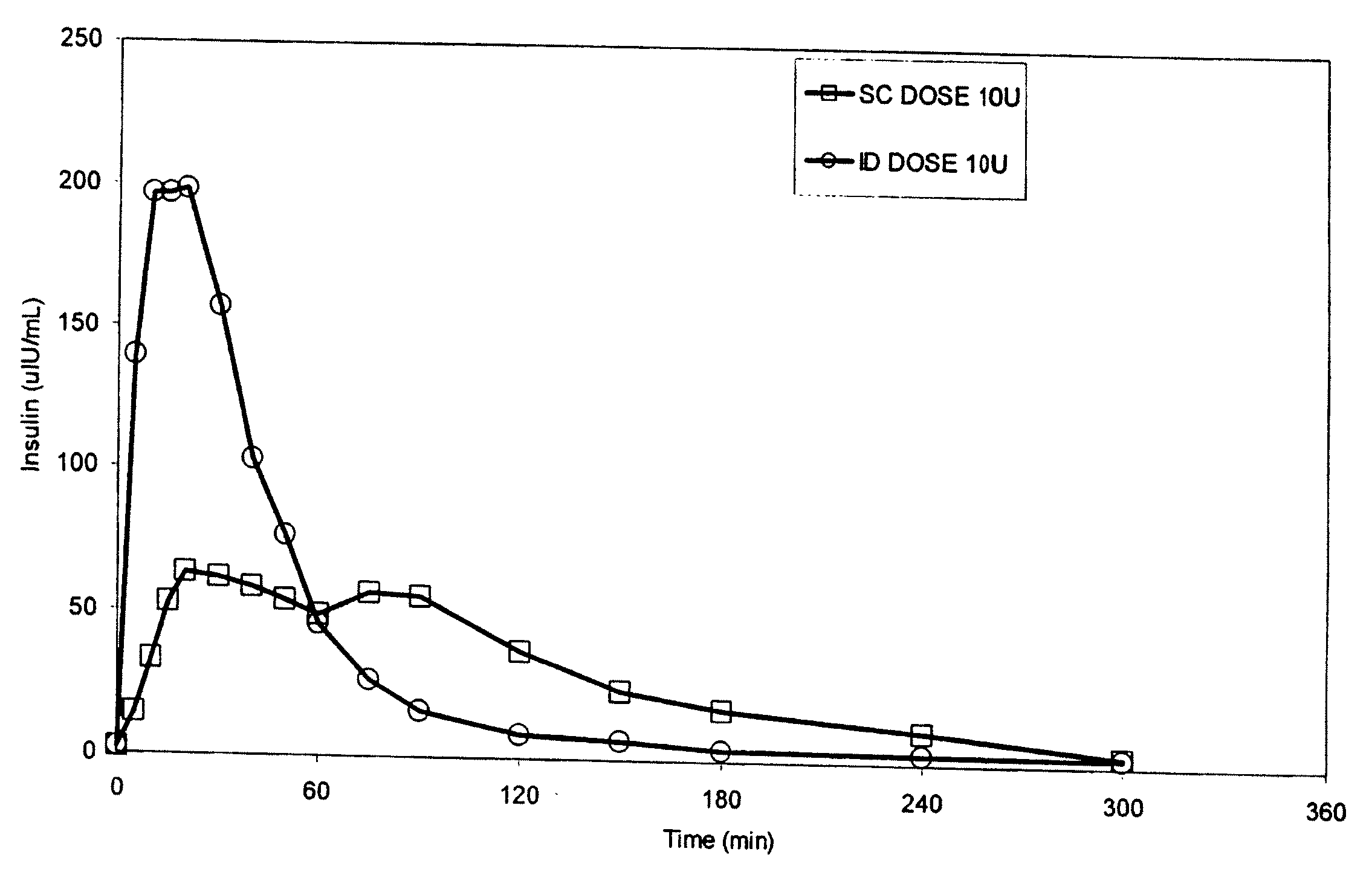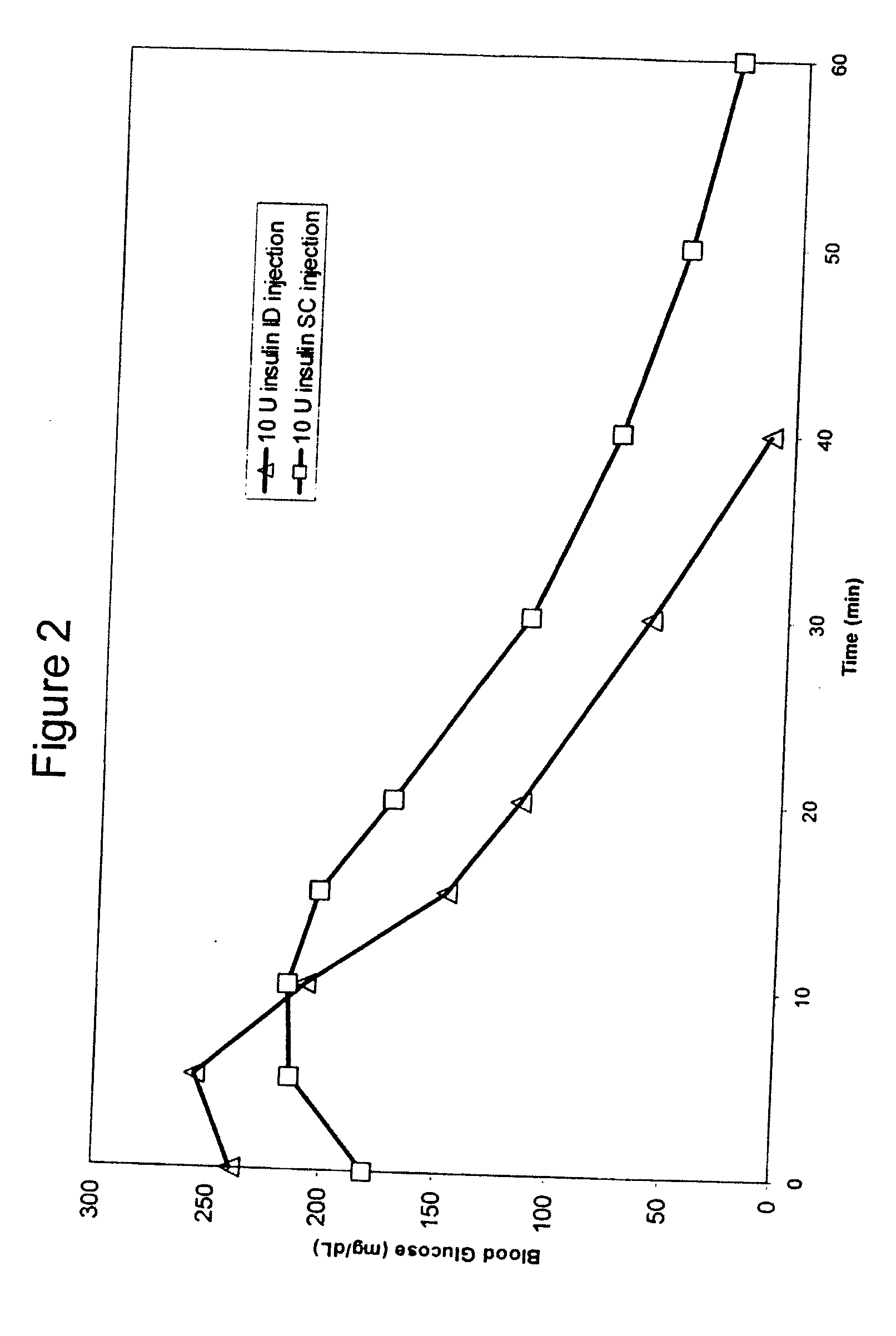Methods and devices for administration of substances into the intradermal layer of skin for systemic absorption
a systemic absorption and intradermal layer technology, applied in the direction of peptides, peptides/protein ingredients, therapy, etc., can solve the problems of increasing the risk of hypoglycemia, overtitudinality, and reducing the effect of iontophoresis, enhancing iontophoresis, and altering the parameters of pharmacokinetics and pd of administered substances
- Summary
- Abstract
- Description
- Claims
- Application Information
AI Technical Summary
Benefits of technology
Problems solved by technology
Method used
Image
Examples
example i
[0065]Slow-infusion ID insulin delivery was demonstrated in swine using a hollow, silicon-based single-lumen microneedle (2 mm total length and 200×100 μm OD, corresponding to about 33 gauge) with an outlet 1.0 μm from the tip (100 μm exposed height), was fabricated using processes known in the art (U.S. Pat. No. 5,928,207) and mated to a microbore catheter (Disetronic). The distal end of the microneedle was placed into the plastic catheter and cemented in place with epoxy resin to form a depth-limiting hub. The needle outlet was positioned approximately 1 mm beyond the epoxy hub, thus limiting penetration of the needle outlet into the skin to approximately 1 mm, which corresponds to the depth of the intradermal space in swine. The catheter was attached to a MiniMed 507 insulin pump for control of fluid delivery. The patency of the fluid flow path was confirmed by visual observation, and no obstructions were observed at pressures generated by a standard 1-cc syringe. The catheter wa...
example ii
[0066]Bolus delivery of Lilly Lispro fast acting insulin was performed using ID and SC bolus administration. The ID injection microdevice was dermal access array design SS3S—34—1. 10 international insulin units (U) corresponding to 100 uL volume respectively, were administered to diabetic Yucatan Mini swine. Test animals had been previously been rendered diabetic by chemical ablation of pancreatic islet cells, and were no longer able to secrete insulin. Test animals received their insulin injection either via the microneedle array or via a standard 30 G X ½ in. needle inserted laterally into the SC tissue space. Circulating serum insulin levels were detected using a commercial chemiluminescent assay kit (Immulite, Los Angeles, Calif.) and blood glucose values were determined using blood glucose strips. ID injections were accomplished via hand pressure using an analytical microsyringe and were administered over approximately 60 sec. By comparison, SC dosing required only 2-3 sec. Ref...
example iii
[0067]Lilly Lispro is regarded as fact acting insulin and has a slightly altered protein structure relative to native human insulin. Hoechst regular insulin maintains the native human insulin protein structure that is chemically similar, but has slower uptake than Lispro when administered by the traditional SC route. Both insulin types were administered in bolus via the ID route to determine if any differences in uptake would be discernable by this route. 5 U of either insulin type were administered to the ID space using dermal access microdevice design SS3S—34—1. The insulin concentration verses time data shown in FIG. 3. When administered by the ID route the PK profiles for regular and fast-acting insulin were essentially identical, and both insulin types exhibited faster uptake than Lispro given by the traditional SC route. This is evidence that the uptake mechanism for ID administration is minimally affected by minor biochemical changes in the administered substance, and that ID...
PUM
| Property | Measurement | Unit |
|---|---|---|
| Length | aaaaa | aaaaa |
| Length | aaaaa | aaaaa |
| Length | aaaaa | aaaaa |
Abstract
Description
Claims
Application Information
 Login to View More
Login to View More - R&D
- Intellectual Property
- Life Sciences
- Materials
- Tech Scout
- Unparalleled Data Quality
- Higher Quality Content
- 60% Fewer Hallucinations
Browse by: Latest US Patents, China's latest patents, Technical Efficacy Thesaurus, Application Domain, Technology Topic, Popular Technical Reports.
© 2025 PatSnap. All rights reserved.Legal|Privacy policy|Modern Slavery Act Transparency Statement|Sitemap|About US| Contact US: help@patsnap.com



